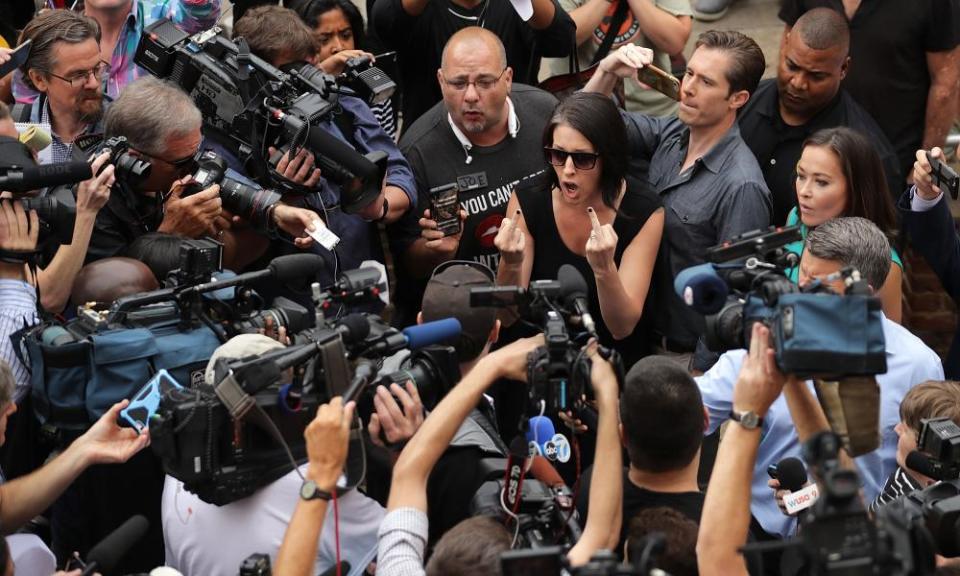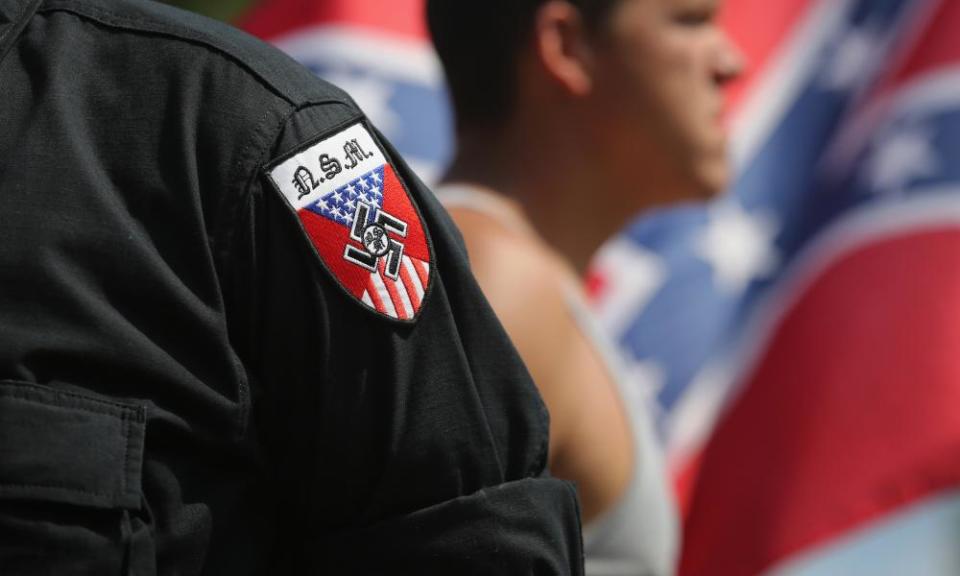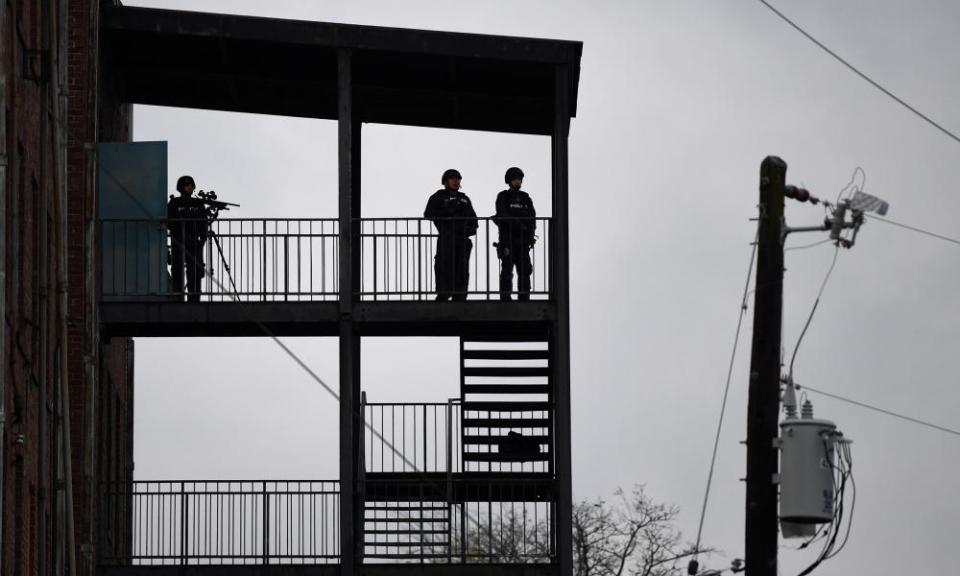Are media giving neo-Nazis the oxygen of publicity or exposing ugly truth?
A recent New York Times profile of a Holocaust denier was criticised as overly sympathetic but journalists face tough decisions when covering the far right

When Alfred Münzer, a 76-year-old Holocaust survivor, read a major newspaper profile of a young “Nazi sympathizer next door”, he was shaken.
The New York Times profile, which focused on a 29-year-old Holocaust denier’s pop culture tastes and listed items in his wedding registry, has been criticized as painting a neo-Nazi in an overly sympathetic light. Many readers argued it should not have been published at all.
Münzer, who volunteers at the United States Holocaust Memorial Museum in Washington, thought the profile lacked some crucial context. But he also believed it told an important story.
“The fact that there are really ordinary people who have beliefs that are really so reminiscent of Nazi Germany is absolutely frightening,” said Münzer, whose two older sisters and father died in Nazi concentration camps. “This is not just a crazy fringe.”
Münzer has been increasingly disturbed by what he has seen in the US over the past two years: a presidential campaign driven by racist, xenophobic, Islamophobic rhetoric and policies; hundreds of neo-Nazis and white supremacists marching openly through the streets of Charlottesville, Virginia, in August; a president who had to be prompted to explicitly condemn those neo-Nazis, rather than casting blame for violent clashes on “many sides”.
Then on Wednesday, as Americans debated the ethics of giving media attention to hate groups, Donald Trump tweeted three pieces of anti-Muslim propaganda from a fringe Islamophobic group, Britain First.
“To me, it’s incredible that an American president would retweet hate messages like that,” Münzer said. “It’s just totally incredible.”
Trump’s tweets sparked international headlines about a racist group with a few hundred members which is best known for harassment campaigns. A rightwing terrorist shouted “Britain first” before killing MP Jo Cox last year. The party’s deputy, found guilty last year of religiously aggravated harassment, received just 56 votes in her last run for parliament. Britain First was recently deregistered by the UK election watchdog, after failing to update its paperwork.
Like neo-Nazi groups in the US, Britain First has used stunts, harassment and digital provocation to attract attention and build its profile, despite having a tiny membership and no political power. Covering such groups, which try to weaponize even negative media coverage as a recruiting tool, has been a constant challenge for journalists. Critics have questioned whether the prominence and volume of such coverage has only served to make fringe groups more powerful.
In the US, neo-Nazi leaders have rejoiced at the coverage they have received, with three prominent far-right racists gushing on a podcast a year ago that the coverage had been “very good, all the things they’re doing are so good”.
“The coverage only has one effect, which is the normalization of our ideas. And it doesn’t take a political scientist to figure that out. If it isn’t purposeful, then it is absurd incompetence,” said one neo-Nazi internet troll.
“I think in a weird level the left, like, secretly wants us to rise,” said Richard Spencer, who was profiled in 2016 as America’s blazer-clad, “dapper white nationalist”.
Such profiles of Spencer, who has degrees from elite American universities, sparked the first major wave of public outrage at news articles about white supremacists that portrayed them as bizarre and fascinating characters rather than dangerous threats.
Americans of color have been quick to raise concerns about this kind of coverage, said Whitney Phillips, a digital media scholar who studies trolling, conspiracy theories and hate groups. Some coverage of white supremacists is implicitly filtered through a white perspective, she said, providing white audiences with shocking stories of “wayward white folks” rather than focusing on the danger or anxiety faced by communities of color.
Part of the problem with the New York Times profile of the “Nazi next door” was that “they didn’t talk to that guy’s black neighbors”, Phillips said. “They weren’t asking questions of the groups that these ideologies create a hostile environment for.”

The crucial question when profiling a neo-Nazi is “who have they harmed”, she said.
Heidi Beirich, who leads the intelligence project at the Southern Poverty Law Center, which tracks hate groups and individual extremists, said white supremacist groups must be covered by the media “because they are a threat to democracy, a threat in terms of domestic terrorism and hate crime”.
Despite criticisms of the volume of media coverage of white supremacist groups, white supremacist violence is not covered well, Beirich said. It tends to treat white supremacist killers as individuals, rather than portraying their violence as inspired by a single ideology and the result of a process of radicalization, as coverage of Islamic State-linked terrorism tends to do.
“It’s like they’re all one-offs,” Beirich said. “We are very reluctant to look at ourselves, our own culture, as a font for this violence. It is a lot easier to point the finger at something coming from Iraq or Syria.”
Some Americans on both left and right continue to ask why fringe hate groups are being covered by the media at all, arguing that their views are ludicrous. Beirich, like other experts who study racist extremists, contested such assumptions.
“The US, people have to remember, was founded on white supremacy and slavery, and it didn’t dismantle white supremacy as its form of government until the mid-1960s,” she said. “Black people and people of color were legally discriminated against. Hate groups – their views, most of them, would have been considered totally normal in 1965.”
‘A reverberating effect’
Joan Donovan, a researcher at the Data and Society institute who studies how white supremacist groups manipulate the media, says articles about hate groups should be treated with the same caution as articles about suicide, where the wrong kind of coverage runs the risk of causing real harm.
News coverage of extremist groups may have “a similar kind of reverberating effect”, Donovan said, adding that white supremacist activists run media-based movements and no matter how ostensibly negative news coverage might be, any mainstream attention provides validation and fodder for their activism.
Donovan recommends that journalists use “strategic silence” when covering hate groups.
“If there is no newsworthy event compelling you to cover this, it’s not a good idea to go searching for these stories,” she said. Local neo-Nazi rallies, like a recent one in Shelbyville, Tennessee, should primarily be covered locally and not as a major national story, she argued.

Phillips, who has interviewed 50 journalists for a project on the difficulties of covering conspiracy theorists and hate groups, studies the way media coverage can “amplify” dangerous lies and hoaxes, helping them spread and become entrenched. Media coverage of bigotry and falsehood is not a neutral force, she said. A news article about a harassment campaign, for instance, will prompt even more harassment of the original target, “and it will increase the likelihood that those tactics will be used in the future”.
The way news coverage can amplify harassment, rather than put an end to it, was clear earlier this year during a campaign of neo-Nazi abuse directed towards Jewish residents of Whitefish, Montana, a town where Richard Spencer’s family owns a vacation home. Whitefish residents said each wave of news coverage seemed to spark a new round of abuse. Neo-Nazi trolls used lurid claims – suggesting they bus in skinheads to hold an armed hate march in the middle of January – to prompt continued press attention and international coverage.
But Phillips said that simply not covering harrassment may not be the right choice, either. “If you have a rise in far-right extremism, you can’t just turn away,” she said.
In an onstage interview on Thursday, the New York Times editor, Dean Baquet, defended the paper’s neo-Nazi profile, saying the degree of outrage it had inspired was “the most ridiculous overreaction to a story” and that the piece had been right to provide a portrait of modern extremism that was not driven by “guys who live in the hills of Alabama smoking pipes”.
‘Playing with fire’
Münzer, the Holocaust survivor, did not express particular interest, as the Times’ article’s author had done, in the “obscure” soul of one neo-Nazi and how he had gone astray. He thought the the article should have pushed more into questions of collective responsibility.
“Where did these feelings come from?” he asked. “What did we do wrong? How does this represent a failing of the schools? Or the failing of the way we teach history? A failure really to communicate what happened or the dangers of Nazis and the danger of racism – and that they can lead to murder?”
It was not news to him that citizens with otherwise normal-seeming lives could become Nazis. It was an ordinary man, and a secret member of the Dutch Nazi party, who turned in Münzer’s sisters, eight-year-old Eva and six-year-old Leah, to the authorities. The two girls were sent to Auschwitz. The man’s wife, who had tried to protect the girls, was also sent to prison.
Münzer said journalists should focus more on ordinary heroes willing to confront the rise of fascism. When Münzer grew up in hiding in the Nazi-occupied Netherlands, it was a Dutch Indonesian family who took him in and a Muslim nanny who served as the Jewish baby’s surrogate mother. There were people of five religions in the household that risked their own safety to protect him. The Muslim woman who cared for him slept with a knife on her pillow, ready to defend his life.
“Hatred, whether it’s directed against Jews, against Muslims, against anyone who is perceived as the other, is dangerous, and can really be a prelude to murder,” he said. “I think this is really playing with fire. It’s stoking the fires of hatred.”
At the same time, he said: “I’m seeing more people willing to stand up and speak up. People are beginning to really confront the hate. I see that among young people, and that’s very encouraging.”

